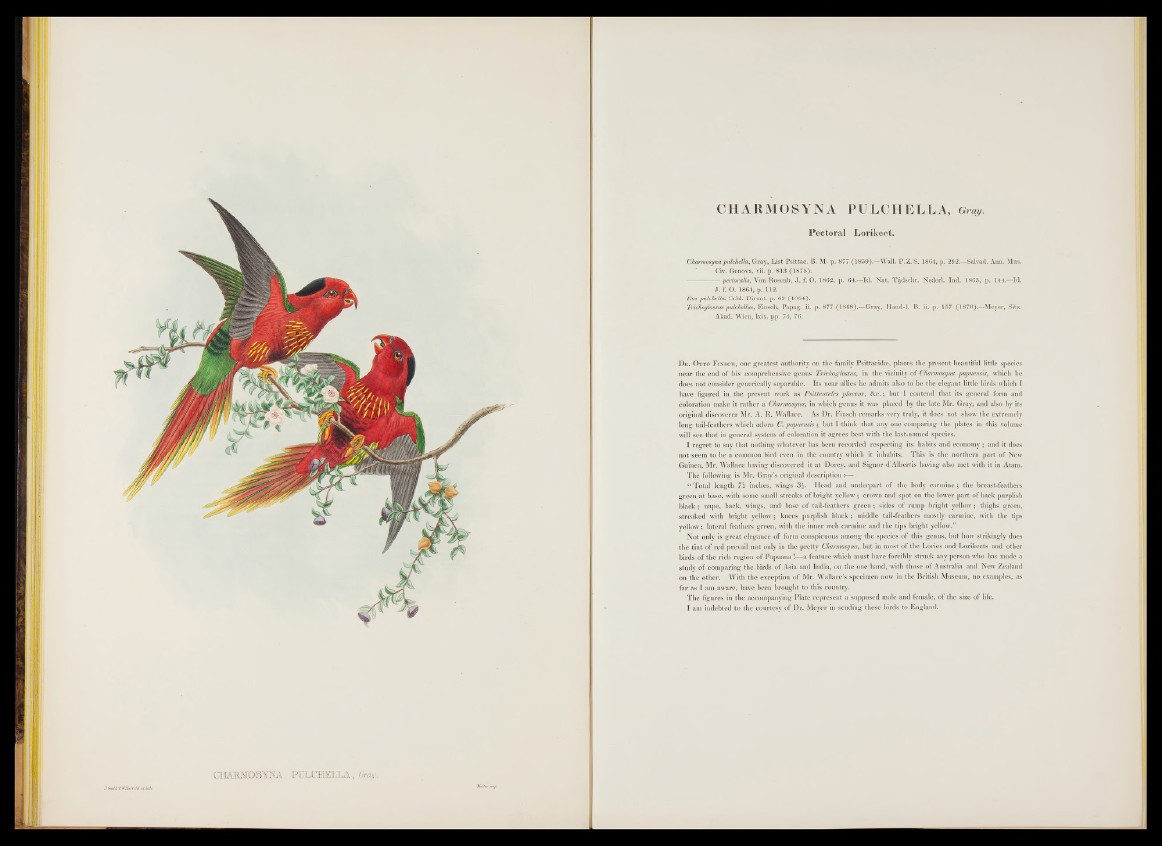
FDtCHEIJLA» Gra
CHARMOSYNA PULCHELLA, Gray.
Pectoral Lorikeet.
Charmosyna pulchella, Gray, List Psittac. B. M. p. 877 (1859).—Wall. P. Z. S. 1864, p. 292.—Salvad. Ann. Mus.
Civ. Genova, vii. p. 813 (1875).
— pectoralis, Von Rosenb. J. f. O. 1862, p. 64.—Id. Nat. Tijdschr. Nederl. Ind. 1863, p. 144.—Id.
J . f. 0 . 1864, p . 112.
Eos pulchella, Schl. Dirent. p. 69 (1864).
Trichoglossus pulchellus, Finsck, Papag. ii. p. 877 (1868).—Gray, Hand-1. B. ii. p. 157 (1870).—Meyer, Sitz.
Akad. Wien, lxix. pp. 74, 76.
D r . O tto F insch, our greatest authority on the family Psittacidse, places the present beautiful little species
near the end o f his comprehensive genus Trichoglossus, in the vicinity o f Charmosyna papuensis, which he
does not consider generically separable. Its near allies he admits also to be the elegant little birds which I
have figured in the present work as Psitteuteles placens, & c .; but I contend th at its general form and
coloration make it rather a Charmosyna, in which genus it was placed by the late Mr. Gray, and also by its
original discoverer Mr. A. R. Wallace. As D r. Finsch remarks very truly, it does not show the extremely
long tail-feathers which adorn C. papuensis ; but I think th at any one comparing the plates in this volume
will see th at in general system o f coloration it agrees best with the last-named species.
I reg re t to say th at nothing whatever has been recorded respecting its habits and economy ; and it does
not seem to be a common bird even in the country which it inhabits. This is the northern p art o f New
Guinea, Mr. Wallace having discovered it a t Dorey, and Signor d’Albertis having also met with it in Atam.
T h e following is Mr. Gray’s original description :—
“ Total length 7 \ inches, wings 3 j . Head and underpart o f the body c a rm in e ; the breast-feathers
green a t base, with some small streaks o f bright yellow; crown and spot on the lower p art o f back purplish
b la c k ; nape, back, wings, and base o f tail-feathers green ; sides o f rump bright yellow; thighs green,
streaked with bright yellow; knees purplish b la c k ; middle tail-feathers mostly carmine, with the tips
yellow; lateral feathers green, with the inner web carmine and the tips bright yellow.”
No t only is great elegance o f form conspicuous among the species o f this genus, but how strikingly does
the tint o f red prevail not only in the. pretty Charmosyna, but in most o f the Lories and Lorikeets and other
birds o f the rich region o f P apuan a !—a feature which must have forcibly struck any person who has made a
study o f comparing the birds of Asia and India, on the one hand, with those of A ustralia and New Zealand
on the other. With the exception o f Mr. Wallace’s specimen now in the British Museum, no examples, as
far as I am aware, have been brought to this country.
The figures in the accompanying Plate represent a supposed male and female, o f the size o f life.
I am indebted to the courtesy of D r. Meyer in sending these birds to England.